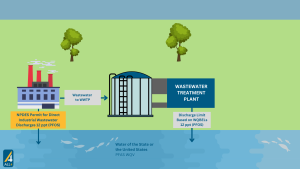Michigan Regulates PFAS via NPDES
Posted: October 25th, 2023
Authors: Cody F.
On March 14, 2023, the Michigan Department of Environment, Great Lakes, and Energy (EGLE or department) published an interoffice communication summarizing a comparison of the department’s current strategy for using the National Pollutant Discharge Elimination System (NPDES) to regulate the discharge of per- and polyfluoroalkyl substances (PFAS) with that of the U.S. Environmental Protection Agency (U.S. EPA). The communique outlined two of the primary sources of PFAS being discharged directly to surface waters: industrial facilities and municipal publicly owned treatment works (POTW). In the same month, EGLE published revisions to guidance documents for NPDES permitting strategies around these two sources, which provide additional insight into what PFAS limits, monitoring and reporting requirements, and enforcement will look through the lens of the NPDES program in Michigan.
Background
In February 2018, at the recommendation of their Wastewater Workgroup, the EGLE launched the Industrial Pretreatment Program (IPP) PFAS Initiative, which prompted investigative activities such as conducting point source monitoring, targeted sampling, and identification of significant sources of PFAS in surface waters. Note that EGLE was previously the Michigan Department of Environmental Quality (MDEQ), which appears in this and other publications from the department before April 22, 2019. The following year, the Surface Water Workgroup began sampling surface waters around the state and continued at an increasing pace through 2022. Based on the monitoring results and Michigan’s Part 57 Rule (MCL §323.1057), which allows for narrative methods in the development of Water Quality Values (WQV) protective of human health and aquatic life, WQV for the following three PFAS were either revised or published for the first time:
| Human Noncancer Value (HNV) [Nanograms per Liter (ng/L)] |
||
| Chemical | Drinking | Nondrinking |
| Perfluorooctanesulfonic Acid (PFOS) | 11 | 12 |
| Perfluorooctanoic Acid (PFOA) | 66 | 170 |
| Perfluorobutanesulfonic Acid (PFBS) | 8,300 | 670,000 |
As a result, water quality-based effluent limits (WQBELs) for surface water discharges of toxic substances, based on Michigan’s Part 8 Rules (MCL §§323.1201-1221), can be developed for receiving waters and will be incorporated into permit limits going forward. However, based on the high concentrations and prevalence identified by surface water monitoring, EGLE chose to focus on PFOS in developing a permitting strategy for POTW. The department then developed and published an online mapping tool for identifying municipal wastewater treatment plants (WWTP), which is another way to describe a POTW, and categorizing them by PFAS source classification. The Michigan IPP WWTP PFAS Status tool categorizes these WWTP by EGLE’s new classification system, which directly relates to the regulatory requirements for that facility and service region.
Publicly Owned Treatment Works
The classification system that EGLE has developed for determining monitoring requirements for WWTP is outlined in the Municipal NPDES Permitting Strategy for PFOS and PFOA. The new system categorizes facilities into “Bins” based on the results of effluent testing as well as the potential of their Industrial Users (IU) to be contributing sources of PFOS, the most prevalent PFAS based on the monitoring data collected. These Bin classifications are outlined in Table 1:
Table 1
Bin Categories for WWTP with PFOS
| Bin | IU Sources Present | PFOS Effluent Data > WQBEL | PFOS Effluent Data (ng/L; ppt) |
| 3b | Yes | Yes | ≥ 50 |
| 3a | Yes | Yes | 13-49 |
| 2 | Yes | No | ≤ 12 |
| 1 | No | No | < 12 |
These criteria are straightforward and objective; however, another more subjective factor, reasonable potential, is implemented in concert with the criteria above. Bin 3a or 3b designations appear to be the least subjective category, reserved for facilities that have IU sources and WWTP effluent data that supports high levels of PFOS passing through the treatment system. Bins 2 and 1, on the other hand, are subject to less frequent monitoring and are not all immediately subject to pollutant minimization, source evaluation, or corrective action plans. Instead, the guidance indicates that outside of some routine monitoring for all Bins there would only be additional requirements imposed if a triggering event occurs. A triggering event will most likely be defined as an exceedance in WQBELs during routine monitoring, but it is not unreasonable to think that EGLE could justify further action based on a different, more qualitative definition of a triggering event.
Direct Discharges from Industrial Sources
Industrial facilities (e.g., manufacturing, utilities, transportation) that discharge wastewater or storm water, and have been identified as known or suspected sources of PFAS, can expect to have monitoring, reporting, or even voluntary administrative consent orders associated with their next permit renewal. According to Table 1 of the communique, the following types of facilities have been identified thus far:
- Metal Finishing
- Airports and Military Installations
- Landfills
- Chemical Manufacturers
- Petroleum Refineries
- Bulk Fuel Transfer Facilities
- Pulp & Paper Manufacturers
- Automotive Manufacturing Facilities
EGLE makes it clear that a facility’s industrial category will not preclude them from PFAS regulation, or in other words, no facility is off the hook. The industrial wastewater and storm water guidance goes on to say that when PFAS is not a requirement of a facility’s current permits, and neither the facility or EGLE knew of the presence of PFAS at that time, then the presence of PFAS in a discharge is not a violation. In this scenario, EGLE suggests that voluntary administrative consent orders (ACO) will be the preferred resolution, but firmly outlines how the failure of a facility to enter into the ACO could result in revocation of permits and ultimately enforcement action for unauthorized discharges.
Regardless of industrial activity or size, the department has promised regulation of PFAS sources discharging to surface waters, specifically stating that limits will be incorporated into any NPDES permits issued after October 1, 2021, and can be anticipated to expand that where it hasn’t already. ALL4 has confirmed that these limits have already been implemented into municipal permits and those municipalities have implemented PFAS into their respective IU permits.
What Actions Should You Take
The significance of upcoming PFAS regulations is widely discussed, although rarely clear. In this case, however, it is abundantly clear how EGLE is planning to establish and enforce wastewater and stormwater discharge limitations on industrial and municipal dischargers. Whether your facility discharges directly to surface water or a POTW, if the facility has been identified as a source of PFAS, then it is highly likely that PFAS limits will be implemented into your next NPDES permit. If you have not been identified as a source, but your facility is in one of the industries mentioned above, then it’s more than likely that EGLE will want to discuss PFAS during your next permit renewal cycle.
It’s critical for your facility to determine whether PFAS discharge limits will be implemented in your wastewater or stormwater permit(s). If your facility has already been issued PFAS discharge limits, or has been subject to enforcement actions, identifying the source of PFAS at your facility, treatment or disposal options, and alternatives for PFAS-containing process materials is crucial for compliance. In either case, developing and executing a sound strategy around PFAS discharges could be the difference between maintaining permit compliance and harsh permit requirements, fines and violations, and public notices.
ALL4 is well positioned to provide strategic support in the form of sampling and analysis plans, PFAS alternatives assessments, treatment or disposal investigations, and implementation of permitting strategies. ALL4 will continue to monitor regulatory developments regarding PFAS in Michigan and at the federal level. If you are looking for guidance or have questions on navigating upcoming permitting or compliance issues around PFAS, please contact Cody Fridley at 269.716.6537 or CFridley@all4inc.com, or Tia Sova at TSova@all4inc.com.


